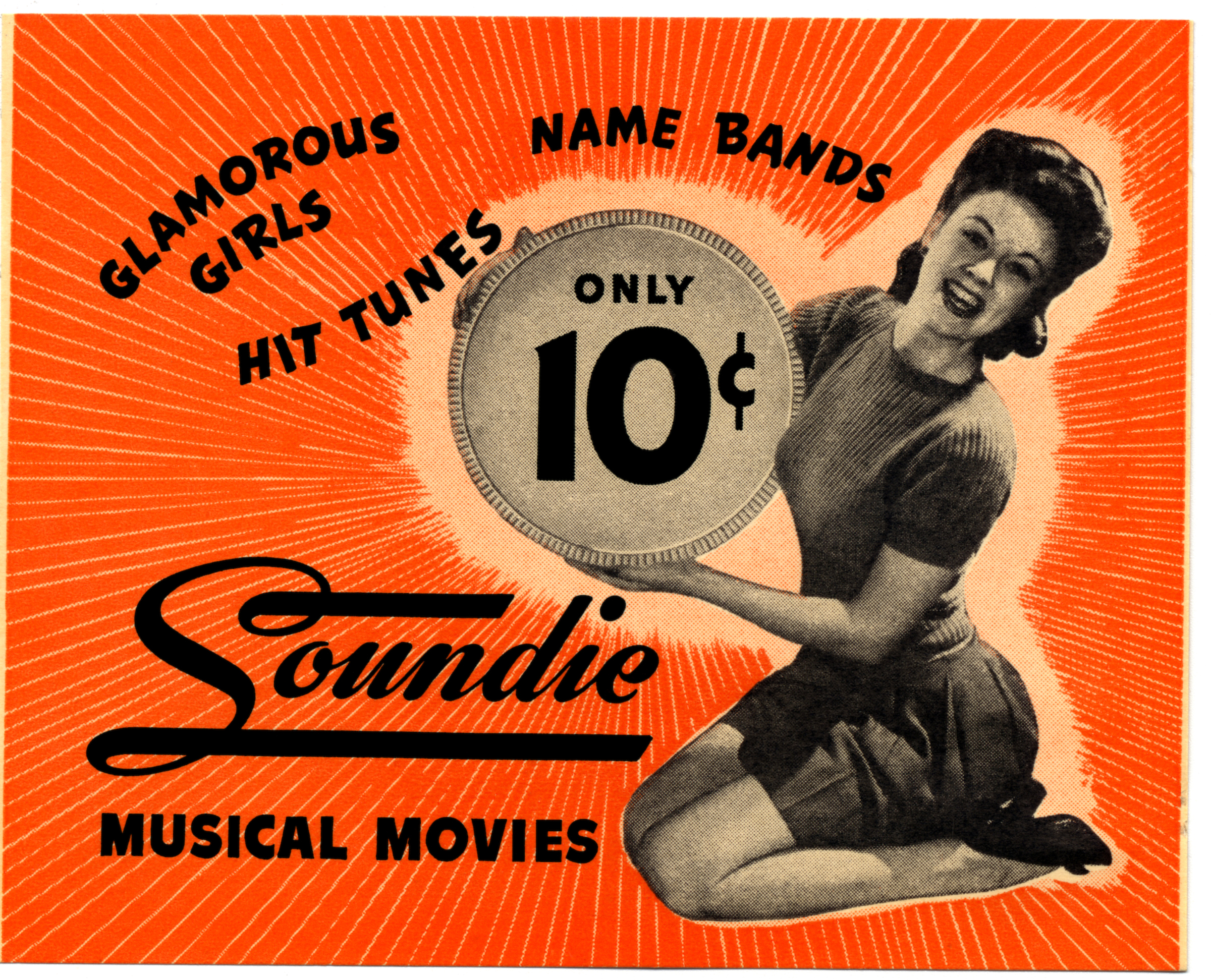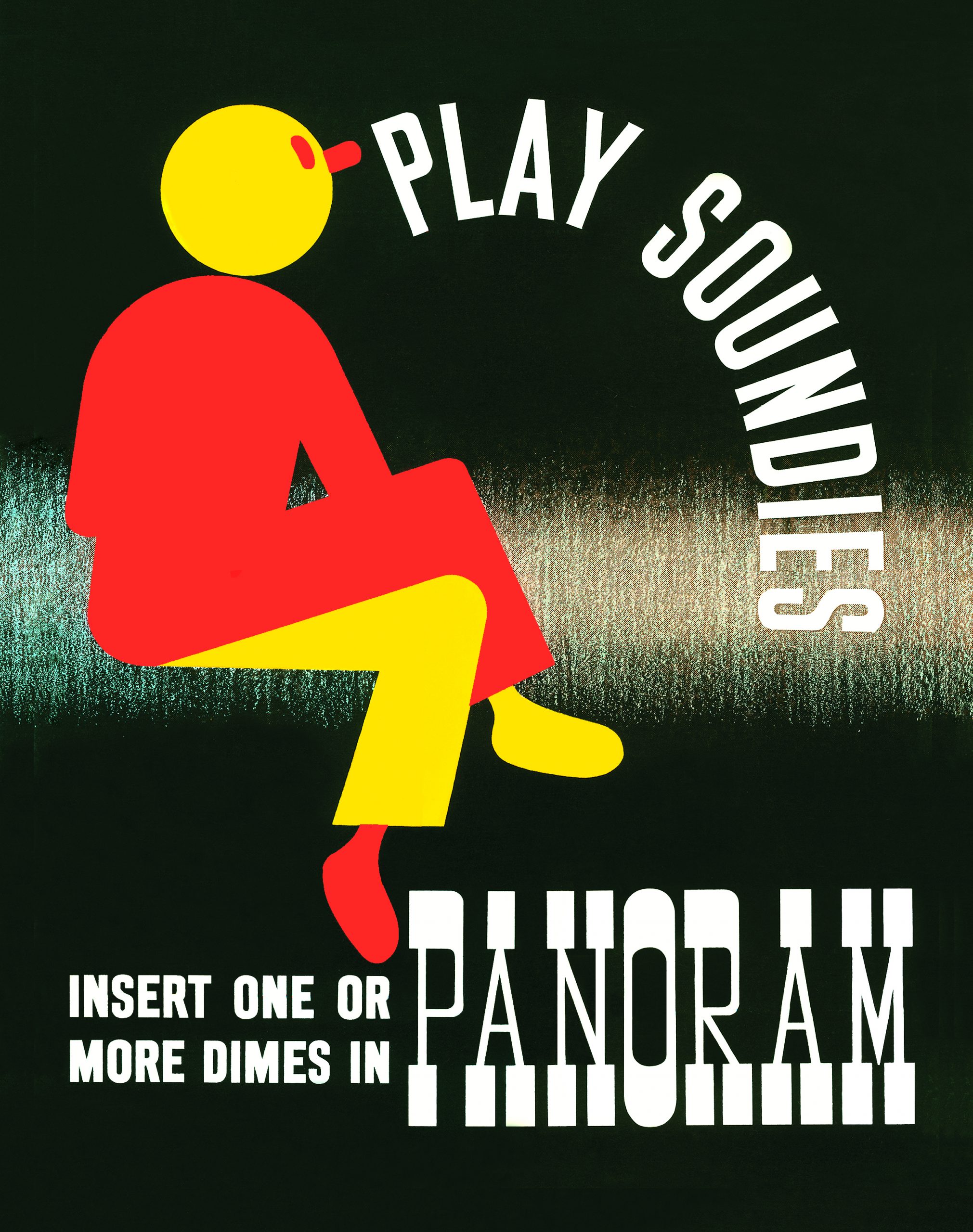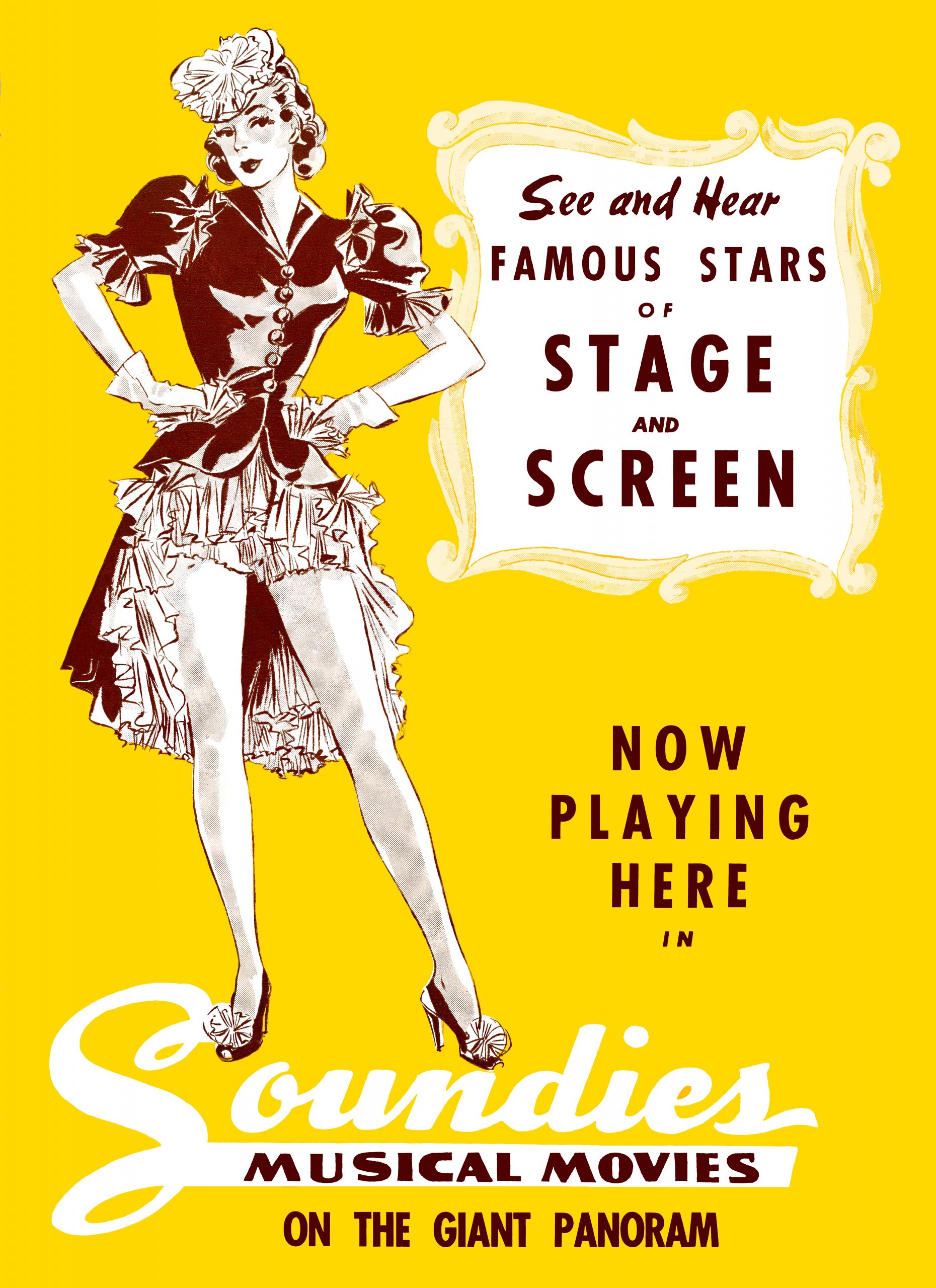INTRODUCTION
Every so often questions arise concerning the soundtrack of the SOUNDIE Sugar Hill Masquerade (After You’ve Gone). This is quite surprising since, production documents aside, the featured soloist is without question Roy Eldridge, performing the “standard band arrangement” with the Gene Krupa orchestra. It is time to put this question to rest with a complete session description of this important series of SOUNDIES.
Negotiations for this session were completed during the fall of 1941, with the Mills Novelty Company and MCA agreeing to feature Gene Krupa and his Orchestra in “four talking motion pict.” As it turned out, however, Krupa and his band are seen and heard in only two film shorts, with one additional soundtrack utilized for a dance routine, without an on-screen appearance by the band, some nine months later. This is somewhat unusual for a series of SOUNDIES from Minoco Productions, the New York-based unit led by Jack Berry. A typical Minoco session from 1941-42 should have included four titles, as called for in the MCA contract, and It is not known if time constraints or cost was the determining factor in this abbreviated session.
The publicists at Soundies Distributing Corporation of America were clearly excited about this series, and promoted it to franchise holders as follows:
“His [Krupa’s] outstanding engagements include such spots as Hotel Pennsylvania in New York, College Inn in Chicago, Palomar in L.A. His Columbia records are best sellers. His orchestra features ‘tunes of the Times’ and their dance rhythms are conceded to be among the finest.” “Krupa is the famed Ace Drummer Man.”
Soundtrack recordings
Gene Krupa and his Orchestra, complete with featured trumpet and vocalist Roy Eldridge and band singer Anita O’Day, entered the R.C.A. Victor recording studios (411 Fifth Avenue, New York City) on December 18, 1941, for a standard three hour SOUNDIE recording session. During that time they committed to disk three tunes: Let Me Off Uptown, Thanks for the Boogie Ride and After You’ve Gone. The band was the regular touring and recording band for the period:
Gene Krupa and his Orchestra (Gene Krupa, drums and leader; Roy Eldridge, Al Beck, Graham Young, Norman Murphy, trumpets; Babe Wagner, Jay Kelliher, John Grassi, trombones; “Musky” Ruffo, Sam Listengard, Jimmy (Migliore) Milione, alto saxes; Sam Musiker, clarinet and tenor sax; Walter Bates, tenor sax; Milt Raskin, piano; Ray Biondi, guitar; Ed Mihelich, string bass; Anita O’Day, vocal)
The recording session must have been a rather simple affair since the three songs were parts of the regular “book” and were very familiar to all involved. Much of the strength of the three SOUNDIES can be attributed to the presence of O’Day and Eldridge. Their personal relationship notwithstanding, their on-screen chemistry is strong, and Eldridge is in fine form indeed.
The first sideline session
The following day, December 19, the band traveled to Astoria, Long Island, to the Minoco rental stage at Paramount Studios (3511 35th Avenue, Astoria, Long Island), where the first two numbers (Let Me Off Uptown and Thanks for the Boogie Ride) were filmed to playback. The soundtrack of the third title, After You’ve Gone, was put in the vault, not to be revisited until after the passage of nine months!
The production team in Astoria was composed of Minoco “regulars” from the period. Robert Snody was at the helm as director, quickly committing to film two of the 154 SOUNDIE shorts that he was to direct during 1941-42. Snody, born in April 1898, was involved in film as early as 1921, assisting director Joseph Basil with the Reelart one reel short Bride and Broom. Over a period of more than forty years Snody served a producer, director, writer, editor or production assistant for more than twenty-five feature films. Snody was involved in film as late as 1962, serving as production manager on The Wonderful World of the Brothers Grimm (MGM).
The scripts for these two SOUNDIES, to the extent that they can be referred to as such, were put together by Charles Abbott. John Graham served as an all around “handyman” for the Minoco SOUNDIES production team and is credited in file materials as “assistant director.”
The personnel for the band is unchanged for the sideline session and, assuming that you are viewing a correct image print, the sidemen can be identified as follows:
Gene Krupa, drums and leader; trumpets, left-to-right: Norman Murphy, Al Beck, Graham Young, Roy Eldridge; trombones, left-to-right: Jay Kelliher, John Grassi, Babe Wagner; reeds, bottom row, left-to-right: Sam Listengard, Musky Ruffo, Sam Musiker; reeds, top row, left-to-right, : Jimmy (Migliore) Milione, Walter Bates; Milt Raskin, piano; Ray Biondi, guitar; Ed Mihelich, string bass; Anita O’Day, vocal) (placement identification confirmed by saxophonist Jimmy Migliore)
Let Me Off Uptown (Red Evans; Earl Bostic) – “The Ace Drummer Man” Gene Krupa and his Orchestra – SOUNDIE release 5001, released the week of January 12, 1942
Elton Hill has long been credited as the arranger of this hit tune, although in his notes to the Chu Berry Mosaic box set, Loren Schoenberg cites co-writer Earl Bostic as the sole arranger of this piece; Walter “Gil” Fuller claimed to have contributed to the arrangement, although this is questionable.
SOUNDIE release 5001 is a standard reading of this arrangement, identical to the commercial recording, presented in an entertaining and energetic manner; it is certainly one of the best jazz-related SOUNDIES. The SOUNDIES publicity department commented as follows:
“Let Me Off Uptown” — A new top tune with rave notices in the theatrical sheets. Reis and Taylor, the publishers, have just brought it out as their Number One plug tune and already there are four popular disk recordings on it. Gene Krupa says it is his best number in years and it recently stopped the show every performance at the biggest theater in New England, the Metropolitan in Boston.”
The highpoint of this film, as with the recording, is the interplay between Eldridge and O’Day, complete with the banter between the two (O’Day: “Hey, Joe, you been uptown?” Eldridge: “No, I ain’t been uptown, but I been around.”); O’Day’s vocal and verbal clarion call (“Well, blow Roy, blow.”); and the resultant cheers of the band as then bow toward master Eldridge.
The presentation is enhanced by a dance routine by “Jazzlips” Richardson and Jeanne Bayer. Richardson was a regular on the Harlem scene during the 1920s through 1940s. The Cleveland Gazette (April 1924 and February 1925) notes that Richardson was a “Star of Shuffle Along Co.” Later press notices place him in a revue at the Lafayette Theater in Harlem beginning March 4, 1933. (Others on the bill included Luis Russell and his Orchestra and “Snakehips” Tucker.)
Thanks For the Boogie Ride (R. Buck [could this be Buck Ram?]; Sidney Mitchell) – “The Ace Drummer Man” Gene Krupa and his Orchestra – SOUNDIE release 5407, released the week of February 9, 1942; arranger unknown
This is another strong SOUNDIE entry, only slightly less effective than the previous short in the series. A “motorcycle coppie” (as the lyrics refer to him) is pictured on screen dancing with O’Day. Unfortunately, his name has been obscured in the production file materials.
Again, the on-screen presence of Eldridge and O’Day electrifies the viewer, and makes one question why the duo were not used in the two additional SOUNDIES required in the MCA contract. Certainly, if one were breaking the so-called “color line” in two SOUNDIES, it would mean very little to do so in two more film shorts!
The second sideline session
Sugar Hill Masquerade (After You’ve Gone) (Harry Creamer, Turner Layton) – Walter Fuller and Whitey’s Lindy Hoppers- SOUNDIE release 9505, released the week of November 23, 1942
In September 1942 it was decided to pull the remaining Krupa soundtrack from the shelf and to develop a dance SOUNDIE around the recording. (It is not known whether the September 18, 1942 sideline date for this title refers to the photography of the Walter Fuller combo, the dance routine or both.) The soundtrack features a blistering solo by Eldridge, and an outing on clarinet by Sam Musiker. As noted above, the Krupa band is not seen on screen, but another band is: a four-piece sideline combo led by former Earl Hines trumpet star Walter Fuller.
After leaving the Hines orchestra, Walter Fuller formed a band of his own, spending a large part of the early 1940s in Chicago. Jazz Register (Oct., Nov., Dec. 1965), in an article discussing Fuller’s career, notes, “The band subsequently invaded New York City on August 13, 1942 at Kelly’s Stable on West 52nd Street.” In The World of Earl Hines (Stanley Dance), Fuller recalls that his band played Kelly Stables in New York City for two or three months in 1942. In addition, an article in the Baltimore Afro-American (September 8, 1942) notes that the engagement “gets another extension this week.”
During the opening sequence of the film a broadside is pictured on a brick wall announcing a block party appearance by trumpeter “Hot Lips Fuller” and drummer “Rubber Arms Marshall.” The drummer in question, although not so noted in production file materials, is probably Joe Marshall, who played with Fuller during this period. (Still, a capital “A” on the bass drum suggests that this may be another drummer, yet to be identified.)
It has not been possible to identify the sideline alto sax and trombone; however, assuming that they were pulled from the Fuller band that was performing at Kelly’s Stables, the possibility exists that they are Wilbert Smith and John “Streamline” Ewing.
The dance troupe, Whitey’s Lindy Hoppers, was no stranger to either film in general, or SOUNDIES in particular. Their work, for example, had recently been seen in Hellzapoppin’ (Universal Pictures, 1941) and Hot Chocolate (R.C.M. Productions, 1941). However, it should be noted that this is a different group than appears in the earlier Ellington SOUNDIE. The sideline contract is not completely legible, but the following is the Savoy Ballroom dance team that appears on-screen; the spelling of underlined names has not been verified:
Leon James, Paul Chodwell, Jerome Williams, Theresa Mason, Leona Jones, Eunice Cellere, Harold Daniels, _________ Lee [first name illegible)
The following sideline performers are seen as people attending the block party, and it is certainly possible that some are involved in the dance routine; once again, unverified spellings are underlined.
Edna Mae Harris, Slim Thomas, Ray Harris, Carrie Frederick, Charlie Morrison, Frances Urline Jackson, Dorothy Moss, Thelma Hereford, Estella Marrino, Alyce Barker, Florence Alexander
EVALUATION
The Gene Krupa series of SOUNDIES is, without question, one of the most important of the Minoco sessions produced in the early 1940s. Although the band had previously appeared in a short subject and a pair of features, and would appear in features and shorts throughout the decade, the three SOUNDIES allow us to see and hear the performance of three tunes that were important parts of the band’s book. As mentioned above, the chemistry between Roy and Anita is clearly evident, Roy’s trumpet electrifying, and the band in fine shape. The Gene Krupa band from the early 1940s was a important jazz unit, one that seemed to avoid many of the clichés that had developed in big band presentation. As such, we see a musical organization that was about to transition to the more modern orchestra that Gene would lead in the later 1940s. The only shortcoming of the session is one that was expressed at a recent film program where, after the screening of Let Me Off Uptown, a member of the audience shouted, “More, more more!”



